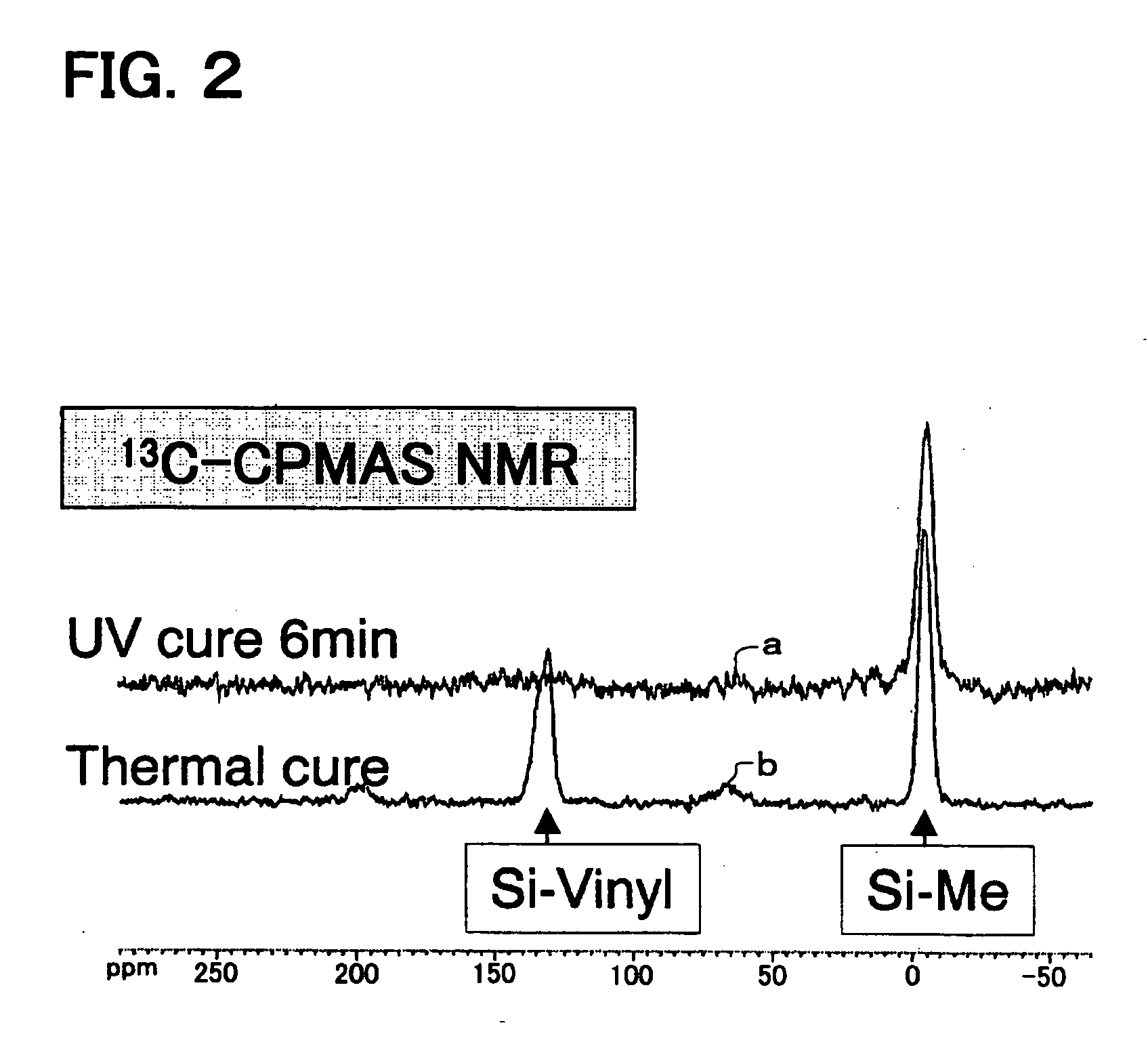Silica-based film, method of forming the same, composition for forming insulating film for semiconductor device, interconnect structure, and semiconductor device
a technology of insulating film and silicon, which is applied in the direction of instruments, photomechanical devices, coatings, etc., can solve the problems of high hygroscopicity of silica film cured by using a photoacid generator or a photobase generator, and the inability to rapidly proceed with dehydration-condensation,
- Summary
- Abstract
- Description
- Claims
- Application Information
AI Technical Summary
Problems solved by technology
Method used
Image
Examples
example 1
4.1.1a Example 1
[0144] A quartz flask equipped with a condenser was charged with 31.8 g of a 20% tetrabutylammonium hydroxide aqueous solution, 143.4 g of ultrapure water, and 448.4 g of ethanol. The mixture was stirred at 25° C. After the continuous addition of 36.2 g of vinyltrimethoxysilane as the compound 1 and 19.9 g of methyltrimethoxysilane and 20.3 g of tetraethoxysilane as silane compounds other than the compound 1 in one hour, the mixture was stirred at 60° C. for one hour. After cooling the reaction solution to room temperature, 1183.6 g of propylene glycol monopropyl ether and 30.6 g of a 20% maleic acid aqueous solution were added. The reaction solution was concentrated under reduced pressure until the solid content became 10% to obtain a film forming composition 1 having a sodium content of 0.7 ppb, a potassium content of 0.4 ppb, and an iron content of 1.7 ppb.
example 2
4.1.1b Example 2
[0145] A quartz flask equipped with a condenser was charged with 5.6 g of a 25% tetrabutylammonium hydroxide aqueous solution, 181.0 g of ultrapure water, and 460.9 g of ethanol. The mixture was stirred at 25° C. After the continuous addition of 11.9 g of vinyltriethoxysilane as the compound 1 and 21.2 g of methyltrimethoxysilane and 19.5 g of tetraethoxysilane as silane compounds other than the compound 1 in one hour, the mixture was stirred at 60° C. for one hour. After cooling the reaction solution to room temperature, 1283.8 g of propylene glycol monopropyl ether and 15.12 g of a 20% maleic acid aqueous solution were added. The reaction solution was concentrated under reduced pressure until the solid content became 10% to obtain a film forming composition 2 having a sodium content of 0.9 ppb, a potassium content of 0.6 ppb, and an iron content of 1.5 ppb.
4.1.1c Example 3
[0146] A quartz flask equipped with a condenser was charged with 18.0 g of a 25% tetramethy...
example 4
4.1.1d Example 4
[0147] In a quartz flask equipped with a condenser, 40.4 g of methylvinyldimethoxysilane as the compound 1 and 103.9 g of methyltrimethoxysilane and 95.4 g of tetraethoxysilane as silane compounds other than the compound 1 were dissolved in 204.4 g of propylene glycol monoethyl ether. The mixture was stirred using a three-one motor to stabilize the solution temperature at 55° C. Then, 254.2 g of ion-exchanged water, in which 0.36 g of oxalic acid was dissolved, was added to the solution in one hour. The mixture was then allowed to react at 55° C. for three hours. After the addition of 917.2 g of propylene glycol monoethyl ether, the reaction solution was cooled to room temperature. The reaction solution was concentrated under reduced pressure until the solid content became 10% to obtain a film forming composition 4 having a sodium content of 0.7 ppb, a potassium content of 1.8 ppb, and an iron content of 1.2 ppb.
PUM
| Property | Measurement | Unit |
|---|---|---|
| Temperature | aaaaa | aaaaa |
| Fraction | aaaaa | aaaaa |
| Density | aaaaa | aaaaa |
Abstract
Description
Claims
Application Information
 Login to View More
Login to View More - R&D
- Intellectual Property
- Life Sciences
- Materials
- Tech Scout
- Unparalleled Data Quality
- Higher Quality Content
- 60% Fewer Hallucinations
Browse by: Latest US Patents, China's latest patents, Technical Efficacy Thesaurus, Application Domain, Technology Topic, Popular Technical Reports.
© 2025 PatSnap. All rights reserved.Legal|Privacy policy|Modern Slavery Act Transparency Statement|Sitemap|About US| Contact US: help@patsnap.com



